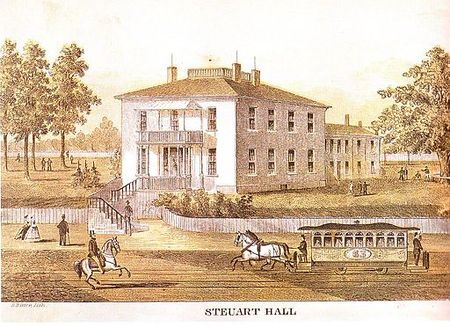Maryland Square

"Maryland Square", later known as "Steuart Hall", was a mansion owned by the Steuart family from 1795 to 1861, located on the western outskirts of Baltimore, Maryland, at the present-day junction of West Baltimore and Monroe streets. In the first year of the American Civil War, the property was confiscated by the United States Federal Government as its owner, George H. Steuart, a former United States Army officer, had resigned his commission to fight in the Confederate Army, in the Army of Northern Virginia as a brigadier general. In 1862, the U.S. War Department built various temporary wooden barracks-style buildings for the Jarvis Military Hospital on the grounds, to care for wounded Union soldiers. The "West Military Hospital" was located on the docks at East Pratt Street, near President Street, at "The Basin" harbor. The Steuart mansion served as the Hospital's headquarters/offices.After the war, in 1866 General Steuart regained possession of his mansion, but did not live there again. He chose to live at "Mount Steuart", his large family plantation further to the southeast of the city of Annapolis on the South River in Anne Arundel County. The next year Steuart leased Maryland Square for use as a school for upper-class boys; it was renamed Steuart Hall. In the 1870s, it was bought by the Roman Catholic order of the Bon Secours Sisters and used as their convent. The mansion was demolished around 1884 for other development. The modern Grace Medical Center, was constructed on the site in 1919 by the religious order and is operating today.
Excerpt from the Wikipedia article Maryland Square (License: CC BY-SA 3.0, Authors, Images).Maryland Square
West Baltimore Street, Baltimore Sowebo
Geographical coordinates (GPS) Address Nearby Places Show on map
Geographical coordinates (GPS)
| Latitude | Longitude |
|---|---|
| N 39.288333333333 ° | E -76.649166666667 ° |
Address
West Baltimore Street 2000
21223 Baltimore, Sowebo
Maryland, United States
Open on Google Maps







